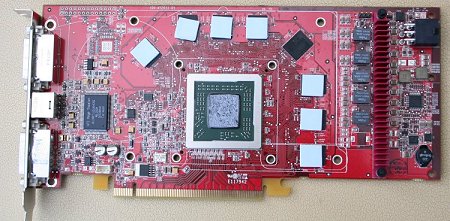ASUS EAX1800XL 256MB

It's somewhat disappointing to note that ASUS, of all card partners, has released what amounts to a reference ATI Radeon X1800 XL 256MB card. The Ruby art on the heatsink's fan is common amongst all reference designs and this could be any one of a dozen cards from any partner, save for the ASUS sticker on the fan itself. ASUS has had a decent history of producing custom cooling on its diverse range, be it for NVIDIA or ATI GPUs, yet that's obviously not in evidence here. In keeping with other X1800 XL 256MB cards, ASUS' is around 240mm long, making the PCB the same size as X1800 XT and GeForce 7800 GTX cards, and around 10mm longer than its direct rival, the GeForce 7800 GT 256MB.

Turning the card to one side shows the single-slot cooler that graces all reference Radeon X1800 XL SKUs, and whilst the cooler/fan combination does a reasonable job of removing the heat away from the GPU core, the off-centre fan blows the warm air right back into the case, which can't be good for PC thermals. We'd like to see the cooler revised to exhaust heat out of the rear, even if that means having a double-height securing plate. Once under heavy 3D load and run in a case with minimal cooling and a reference AMD heatsink, the card's fan intermittently increased the RPM markedly, enough for you to notice it immediately. The annoying factor here was that it would toggle speeds upwards/downwards in fractions of a second, rather than keep the higher RPM running for longer periods. Kind of like depressing and releasing the accelerator pedal on a car every second. A constant pitch would have been preferable.

A thin heatsink covers some of the hot-running power circuitry on the front of the card, and a 6-pin PCI-Express power adapter is required to keep the 320 million transistors ticking along. Just like the reference design, then, ASUS' Radeon X1800 XL has a core frequency of 500MHz; we had hoped of a speed increase from one of ATI's partners, to distinguish their card from the homogeneous crowd. You can see the copper-based heatsink in the background, which gives the card a satisfying weight.

Dual dual-link DVI transmitters are a standard feature on the X1800 line. What it means for you, the consumer, is the ability to run display resolutions up to 2560x1600 pixels off each connector. Will you need this feature? Probably not, but it's nice to know that the card will support it as extra-high resolution panels become affordable over time. It's worth noting that all Radeon X1800 XL cards, and by inference the ASUS model here, benefit from ATI's Avivo display Avivo technology, and in common with multi-GPU technology that is the buzzword for ATI in 2005, the ASUS Radeon X1800 XL can be used in CrossFire mode, assuming it's run on a compatible motherboard and paired up with an X1800-series master card.

Whip off the cooler and the R520 GPU is exposed. Sporting Shader Model 3.0 compatibility, intelligent execution threading and featuring a ring-style memory controller that helps mask access latency, ATI's R520 GPU is a model of efficiency that will do well in shader-heavy titles. 256MBs of Samsung's tasty 1.4ns-rated GDDR3 memory is run at 1GHz, offering 32GB/s bandwidth without taking memory-saving optimisations into account. ATI's Rage Theater ASIC adds in basic VIVO functionality, too.

The back is about as interesting as watching paint dry, and all the component action is contained on the GPU side. ASUS has gone with the reference design that it knows works well. Perhaps the accompanying bundle can make it standout from other 'XLs.









